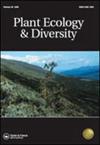委内瑞拉帕拉莫的生态水文学:安第斯高流域的水平衡
IF 1.6
4区 生物学
Q2 PLANT SCIENCES
引用次数: 16
摘要
摘要背景:帕拉莫提供关键的生态系统服务,包括水的管理和供应。为了理解潜在的功能,有必要采用生态系统方法。目的:我们量化了植被和土壤(综合地形和植被单元-TVU)对委内瑞拉帕拉莫微流域水文平衡的综合影响,并分析了其对年际和年际降雨量变化的水文响应。方法:使用TVU气象站和径流站的数据(2008-2016)计算流域水位水文平衡。我们通过计算非标准条件下的蒸散量(ETc-adj)来量化TVU输出的影响。结果:湿地和柏油路的蒸发蒸腾量较高,超过年降水量。灌木林的蒸散量很低。当月降雨量超过90毫米时,páramo水库(土壤、湿地、柏油路)就会重新补给。在干旱年份,水产量较低,水文调节效果较差。在平均年份,流域平衡的投入和产出之间的差异非常小。结论:湿地和柏油路的高而恒定的蒸散量(由于永久的水资源可用性)表明它们可以在干旱期保持流量。它们的高蒸散率被灌木林单位的低蒸散率所补偿,从而降低了流域的平均总蒸散量。流域平衡表明,在这些没有火山土壤的相对干燥的帕拉莫斯,调节能力有限。本文章由计算机程序翻译,如有差异,请以英文原文为准。
Ecohydrology of the Venezuelan páramo: water balance of a high Andean watershed
ABSTRACT Background: The páramo provides key ecosystem services, including regulation and provision of water. To understand the underlying functions, an ecosystem approach is necessary. Aims: We quantified the combined effect of vegetation and soils (integrated topographic and vegetation units – TVU) on the hydrological balance of a Venezuelan páramo micro-watershed and analyse its hydrological response to intra- and interannual rainfall variability. Methods: Data (2008–2016) from meteorological stations of TVUs and of a streamflow station was used to calculate watershed level hydrologic balances. We quantified the impact of the TVUs outputs by calculating evapotranspiration under non-standard conditions (ETc adj). Result: Evapotranspiration of wetlands and tarns was high, exceeding annual precipitation. Shrubland had low evapotranspiration. Recharge of páramo reservoirs (soils, wetlands, tarns) occurred when monthly rainfall exceeded 90 mm. In dry years there were lower water yields with less effective hydrological regulation. In average years the differences between input and output in watershed balances were very small. Conclusions: The high and constant evapotranspiration of the wetlands and tarns (due to permanent water availability) suggests they could maintain streamflow during dry periods. Their high evapotranspiration rates are compensated by low rates in shrublands units, reducing the mean total evapotranspiration of the watershed. The watershed balances suggest a limited regulatory capacity in these relatively dry páramos with no volcanic soils.
求助全文
通过发布文献求助,成功后即可免费获取论文全文。
去求助
来源期刊

Plant Ecology & Diversity
PLANT SCIENCES-
CiteScore
3.30
自引率
0.00%
发文量
26
审稿时长
3 months
期刊介绍:
Plant Ecology and Diversity is an international journal for communicating results and novel ideas in plant science, in print and on-line, six times a year. All areas of plant biology relating to ecology, evolution and diversity are of interest, including those which explicitly deal with today''s highly topical themes, such as biodiversity, conservation and global change. We consider submissions that address fundamental questions which are pertinent to contemporary plant science. Articles concerning extreme environments world-wide are particularly welcome.
Plant Ecology and Diversity considers for publication original research articles, short communications, reviews, and scientific correspondence that explore thought-provoking ideas.
To aid redressing ‘publication bias’ the journal is unique in reporting, in the form of short communications, ‘negative results’ and ‘repeat experiments’ that test ecological theories experimentally, in theoretically flawless and methodologically sound papers. Research reviews and method papers, are also encouraged.
Plant Ecology & Diversity publishes high-quality and topical research that demonstrates solid scholarship. As such, the journal does not publish purely descriptive papers. Submissions are required to focus on research topics that are broad in their scope and thus provide new insights and contribute to theory. The original research should address clear hypotheses that test theory or questions and offer new insights on topics of interest to an international readership.
 求助内容:
求助内容: 应助结果提醒方式:
应助结果提醒方式:


